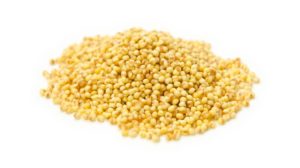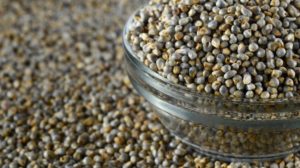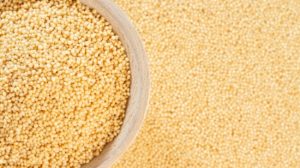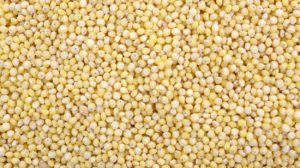Millets are cereal crops grown in the semi-arid regions of Africa and Asia. Did you know that 97% of millet production occurs in developing countries?
These grains have been a part of diets for 7000 years and, over time, made nomads into farmers – thus establishing a society of farmers.
Most farmers favour millet production because of their ability to grow in a short period in harsh, cold climates.
Furthermore, millet is gluten-free and rich in protein, thus consumable by almost everyone!
This article talks about the different types of millet available in the market. Read on to know more!
What are the different types of millet?
There are ten types of millet available today. They are as follows –
- Finger millet
- Foxtail millet
- Sorghum millet
- Pearl millet
- Buckwheat millet
- Amaranth millet
- Little millet
- Barnyard millet
- Proso/Broomcorn millet
- Kodu/Kodo millet
1. Finger millet

Popularly known as Ragi in the Indian subcontinent, this cereal crop serves as a healthy alternative for rice and wheat.
Ragi is rich in calcium, which helps strengthen bones in children. Therefore, gestating mothers should also add ragi to their diets.
Consuming ragi may also prevent bone diseases, such as osteoporosis.
Finger millet, mainly green ragi, has the following benefits –
- Controls blood sugar levels, especially among people with diabetes.
- It helps prevent liver damage.
- It helps lactating women to produce more milk.
2. Foxtail millet

Foxtail millet, also known as Kakum or Kangni, is the second most popular millet produced for consumption.
Like any other millet, Kangni is rich in nutrient value, particularly Vitamin B12.
As some of you might know, Vitamin B12 is beneficial in the following ways –
- It helps maintain the health of nerve and blood cells.
- It prevents megaloblastic anaemia, a rare blood condition that causes you to feel weak and tired.
Foxtail millet is also rich in iron and calcium, which help in muscle strengthening and controlling muscle spasms. Moreover, the amino acids present lower “bad cholesterol” levels, thus preventing severe heart diseases.
3. Sorghum millet
Sorghum millet or Jowar is a type of millet used for making roti, dosa, etc. Sorghum is rich in niacin, a form of Vitamin B. Niacin helps convert food into energy used actively by the body.
A serving of approximately 100 gms of Sorghum millet can provide up to 28% of the required niacin intake along with 11 gms of protein.
Jowar also contains high fibre content, allowing effective digestion of various foods.
4. Pearl millet

Locally known as Bajra, this millet is the most popular grain produced in the Indian and African subcontinents!
Several Indian households use Bajra to cook simple and staple foods, such as khichdi, roti, etc.
Besides the usual benefits of millet, adding Pearl millet to your diet will also keep acidity and stomach ulcers at bay.
Let us look at the nutritional value Bajra provides!
- 10.96 grams of protein
- 11.49 grams of dietary fibres
- 61.78 grams of carbohydrates
- 1456 KJ of energy
- 5.43 grams of fat
Moreover, Bajra can also benefit people battling type 2 diabetes.
5. Buckwheat millet

If your primary concern is weight loss, buckwheat millet is a go-to cereal crop. This millet has higher fibre, protein, and energy value than other grains in its family.
Locally known as Kuttu, Buckwheat millet is also used widely while fasting, especially during Navratras. It helps lower blood pressure levels and helps improve cardiovascular health.
Let us take a look at the nutritional value chart of Buckwheat millet –
- 13.3 grams of protein
- 10 grams of dietary fibre
- 71.5 grams of carbohydrates
- 10% of water content
- 3.4 grams of fat
6. Amaranth millet

Amaranth is a type of millet that has been cultivating for 8000 years. However, it has gained popularity recently along with other grains in its family.
Amaranth millet, locally known as Ramdana, Chola, or Rajgira, is rich in manganese. Manganese helps boost brain functions and prevents neurological adversities.
It also contains phosphorous that helps with bone health. Let us look at the nutritional fact sheet of Amaranth. The measurement per serving per this chart is 246 gms cooked.
- 9.3 grams of protein
- 46 grams of carbohydrates
- 5.2 grams of fat
7. Little millet

Little millet has different names in different regions, such as moraiyo, kutki, sama, shavan, and many more.
Little millet is rich in components such as phenols (commonly known as anti-oxidants) and tannins, which help lower blood pressure levels and manage immuno-responses.
Moreover, this grain has an indefinite shelf-life!
The nutritional value per 100 gms of Little millet is as follows –
- 9.7 grams of protein
- 7.6 grams of dietary fibres
- 4.7 grams of fat
- 67 grams of carbohydrates
- 329 kCal of energy
8. Barnyard millet

Barnyard millet contains a high nutritional value, mainly dietary fibres. Dietary fibres are essential for the proper functioning of digestive processes in humans.
Also known as Sanwa, this millet has a low glycemic index, meaning that it has relatively low carbohydrate content and is slowly digestible. Therefore, barnyard millet is beneficial for people with diabetes.
The nutritional chart of 100g of Barnyard millet is as follows –
- 10.5 grams of protein
- 12.6 grams of dietary fibres
- 3.6 gram of fat
- 68.8 grams of carbohydrate
- 398 kcal of energy.
9. Broomcorn/Proso millet
Broomcorn millet, like most millets, also consists of a low glycemic index and helps maintain blood sugar levels, especially those with type two diabetes.
It also contains essential amino acids that help repair tissues and absorb nutrients.
However, Proso millet makes for a popular bird feed.
10. Kodu/Kodo millet
Kodo millet is known for its high nutrient value in lecithin amino acids, which help increase memory and retention power.
Like Foxtail and Sorghum millet, Kodo millet is also rich in Vitamin B, mainly niacin and folic acid.
Let us look at the nutritional value of Kodo millet per 100 grams –
- 8.3 grams of protein,
- 3.6 grams of fat,
- 9 grams of dietary fibres,
- 65 grams of carbohydrates,
- 353 kcal of energy
Conclusion
Millets are a healthy, nutrient-dense grain that can be incorporated into every diet. Some millets make for healthy alternatives to certain carbohydrates that are considered essential, such as rice and roti.
Just because millets contain high nutritional value, it does not mean that they can not be cooked the tasty way!
If you have tried millets or successfully added them to your daily diet, feel free to share your experience with our readers in the comment box below!
As always, we will update our page with more informative articles. So make sure you stick around or continue to check back for more updates!


